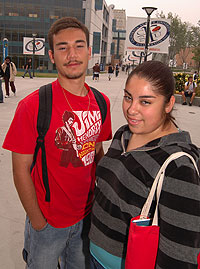GEAR UP Program Succeeds In Helping
Latinos Enter College In fall 1999, Art Castanon and Ana Coria were part of the seventh grade class at Sycamore High School in Anaheim that began GEAR UP — Gaining Early Awareness and Readiness for Undergraduate Program — a six-year curriculum aimed at middle schools in low-income communities to help raise expectations and ensure successful college entry. The program, a partnership with the Anaheim School District, city of Anaheim and Los Amigos, followed the students — which originally numbered around 850 — from Sycamore through Anaheim High School. Castanon and Coria were among the 450 who graduated last spring and, with 29 of their classmates, started their college career last fall at Cal State Fullerton.
The group of 31 is the largest group of Anaheim High graduates to attend Fullerton in 10 years. Overall, the graduating class's postsecondary enrollment was 68 percent, higher than the state and Anaheim High rates, according to David L. Pagni, professor of mathematics and director of GEAR UP. Among other highlights of the program's success: 41 percent of the students completed chemistry or physics; 99 percent graduated from high school; the group completed a college-prep curriculum at a higher rate than the state rate for Latinos and the rate for Anaheim High from previous years; and 13 percent completed an advanced math class, a 30 percent increase from the previous class. The importance of programs like GEAR UP, says Pagni, is "the attention the students get and the constant motivation to pursue post-secondary education. Also, the workshops for parents... the attention given in terms of going to college and financial aid. They don't realize that this is in their realm. It changes their aspirations and opens up insights." One of the challenges, says Patricia Alvarado, GEAR UP coordinator, was that "the school was not a very college-bound environment. In the past, a lot of students would go to community colleges, because no one told them they could do anything else. We told all the students that they could do it. It was also important to have people to look up to, like our tutors — seeing college students." "The tutors were more than tutors," says Pagni. "They
were mentors and role models, stressing the importance of doing well
in school — they were our ambassadors for higher education." "When I started seeing what GEAR UP was all about and got to eighth grade, I was like,'Okay, I can do this. I can go to college.'" Now completing her freshman year, Coria — who is undeclared but thinking about pursuing forensic anthropology — says that the program "was my life saver, because when I started high school, I wasn't sure what I was going to do. GEAR UP helped me with my classes, because I didn't know what I needed to take to get into college. "I didn't know about financial aid, and they brought in people to help with our applications. The program itself gave me hope to come here." Castanon, also undeclared, says, "before I graduated, I was
thinking of going to community college. Patty told me I qualified to
come here, so I submitted an application, but I didn't think
I was good enough. I was surprised when I got the letter in the mail
saying ‘you are accepted.'" With an athletic background — he played baseball in high school — Castanon is considering a degree in kinesiology. With the GEAR UP experience and the possibilities it created, he and his family are now looking at his younger sister to join him. "We have high expectations for her now," he says. |


 Produced by the Office of Public Affairs at California State University, Fullerton.
Contact the
Produced by the Office of Public Affairs at California State University, Fullerton.
Contact the